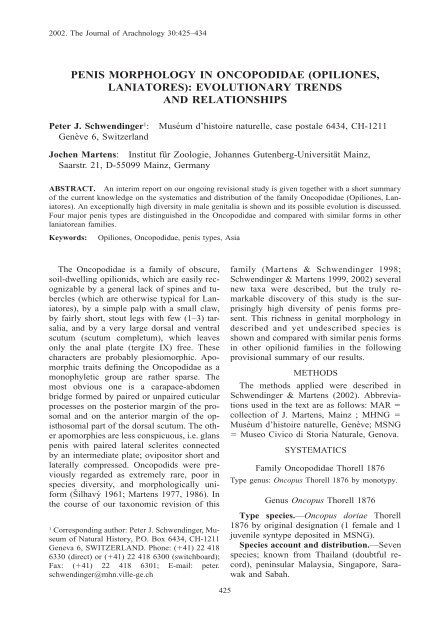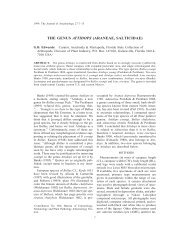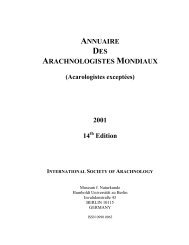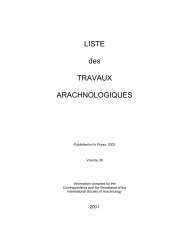penis morphology in oncopodidae - International Society for ...
penis morphology in oncopodidae - International Society for ...
penis morphology in oncopodidae - International Society for ...
Create successful ePaper yourself
Turn your PDF publications into a flip-book with our unique Google optimized e-Paper software.
2002. The Journal of Arachnology 30:425–434<br />
PENIS MORPHOLOGY IN ONCOPODIDAE (OPILIONES,<br />
LANIATORES): EVOLUTIONARY TRENDS<br />
AND RELATIONSHIPS<br />
Peter J. Schwend<strong>in</strong>ger 1 : Muséum d’histoire naturelle, case postale 6434, CH-1211<br />
Genève 6, Switzerland<br />
Jochen Martens: Institut für Zoologie, Johannes Gutenberg-Universität Ma<strong>in</strong>z,<br />
Saarstr. 21, D-55099 Ma<strong>in</strong>z, Germany<br />
ABSTRACT. An <strong>in</strong>terim report on our ongo<strong>in</strong>g revisional study is given together with a short summary<br />
of the current knowledge on the systematics and distribution of the family Oncopodidae (Opiliones, Laniatores).<br />
An exceptionally high diversity <strong>in</strong> male genitalia is shown and its possible evolution is discussed.<br />
Four major <strong>penis</strong> types are dist<strong>in</strong>guished <strong>in</strong> the Oncopodidae and compared with similar <strong>for</strong>ms <strong>in</strong> other<br />
laniatorean families.<br />
Keywords: Opiliones, Oncopodidae, <strong>penis</strong> types, Asia<br />
The Oncopodidae is a family of obscure,<br />
soil-dwell<strong>in</strong>g opilionids, which are easily recognizable<br />
by a general lack of sp<strong>in</strong>es and tubercles<br />
(which are otherwise typical <strong>for</strong> Laniatores),<br />
by a simple palp with a small claw,<br />
by fairly short, stout legs with few (1–3) tarsalia,<br />
and by a very large dorsal and ventral<br />
scutum (scutum completum), which leaves<br />
only the anal plate (tergite IX) free. These<br />
characters are probably plesiomorphic. Apomorphic<br />
traits def<strong>in</strong><strong>in</strong>g the Oncopodidae as a<br />
monophyletic group are rather sparse. The<br />
most obvious one is a carapace-abdomen<br />
bridge <strong>for</strong>med by paired or unpaired cuticular<br />
processes on the posterior marg<strong>in</strong> of the prosomal<br />
and on the anterior marg<strong>in</strong> of the opisthosomal<br />
part of the dorsal scutum. The other<br />
apomorphies are less conspicuous, i.e. glans<br />
<strong>penis</strong> with paired lateral sclerites connected<br />
by an <strong>in</strong>termediate plate; ovipositor short and<br />
laterally compressed. Oncopodids were previously<br />
regarded as extremely rare, poor <strong>in</strong><br />
species diversity, and morphologically uni<strong>for</strong>m<br />
(Sˇilhavy´ 1961; Martens 1977, 1986). In<br />
the course of our taxonomic revision of this<br />
1 Correspond<strong>in</strong>g author: Peter J. Schwend<strong>in</strong>ger, Museum<br />
of Natural History, P.O. Box 6434, CH-1211<br />
Geneva 6, SWITZERLAND. Phone: (�41) 22 418<br />
6330 (direct) or (�41) 22 418 6300 (switchboard);<br />
Fax: (�41) 22 418 6301; E-mail: peter.<br />
schwend<strong>in</strong>ger@mhn.ville-ge.ch<br />
425<br />
family (Martens & Schwend<strong>in</strong>ger 1998;<br />
Schwend<strong>in</strong>ger & Martens 1999, 2002) several<br />
new taxa were described, but the truly remarkable<br />
discovery of this study is the surpris<strong>in</strong>gly<br />
high diversity of <strong>penis</strong> <strong>for</strong>ms present.<br />
This richness <strong>in</strong> genital <strong>morphology</strong> <strong>in</strong><br />
described and yet undescribed species is<br />
shown and compared with similar <strong>penis</strong> <strong>for</strong>ms<br />
<strong>in</strong> other opilionid families <strong>in</strong> the follow<strong>in</strong>g<br />
provisional summary of our results.<br />
METHODS<br />
The methods applied were described <strong>in</strong><br />
Schwend<strong>in</strong>ger & Martens (2002). Abbreviations<br />
used <strong>in</strong> the text are as follows: MAR �<br />
collection of J. Martens, Ma<strong>in</strong>z ; MHNG �<br />
Muséum d’histoire naturelle, Genève; MSNG<br />
� Museo Civico di Storia Naturale, Genova.<br />
SYSTEMATICS<br />
Family Oncopodidae Thorell 1876<br />
Type genus: Oncopus Thorell 1876 by monotypy.<br />
Genus Oncopus Thorell 1876<br />
Type species.—Oncopus doriae Thorell<br />
1876 by orig<strong>in</strong>al designation (1 female and 1<br />
juvenile syntype deposited <strong>in</strong> MSNG).<br />
Species account and distribution.—Seven<br />
species; known from Thailand (doubtful record),<br />
pen<strong>in</strong>sular Malaysia, S<strong>in</strong>gapore, Sarawak<br />
and Sabah.
426 THE JOURNAL OF ARACHNOLOGY<br />
Ma<strong>in</strong> characteristics.—Glans <strong>penis</strong> proximad-directed<br />
(Figs. 1–4); tarsal <strong>for</strong>mula 1-1-<br />
1-1; body large; chelicerae massive, with ventral<br />
process on 2 nd (sometimes also on 3 rd )<br />
article; ventroproximal process on palpal tibia<br />
dist<strong>in</strong>ct; ventral process on palpal trochanter<br />
slightly distad-<strong>in</strong>cl<strong>in</strong>ed.<br />
Genus Gnomulus Thorell 1890<br />
Type species.—Gnomulus sumatranus<br />
Thorell 1891 by rul<strong>in</strong>g of the <strong>International</strong><br />
Commission on Zoological Nomenclature<br />
(2001) (male lectotype, 3 female and 2 juvenile<br />
paralectotypes deposited <strong>in</strong> MSNG).<br />
Species account and distribution.—48<br />
species; known from the Himalayan region<br />
(central and east Nepal, NE-India), southern<br />
Ch<strong>in</strong>a, and from all over SE-Asia, as far east<br />
as Waigeo Island off the northwestern tip of<br />
New Gu<strong>in</strong>ea.<br />
Ma<strong>in</strong> characteristics.—Glans <strong>penis</strong> proximad-directed,<br />
with a tendency <strong>for</strong> reduction<br />
and modification of different elements of the<br />
glans (Figs. 5–22); tarsal <strong>for</strong>mula 2–2–3(2)-<br />
3(2); body small to large; chelicerae weak to<br />
massive, without ventral processes on 2 nd and<br />
3 rd article; ventroproximal process on palpal<br />
tibia absent or developed as a low, rounded<br />
hump (dist<strong>in</strong>ct only <strong>in</strong> G. sumatranus); ventral<br />
process on palpal trochanter ventrad-directed,<br />
distad-directed or absent.<br />
Genus Caenoncopus Martens &<br />
Schwend<strong>in</strong>ger 1998<br />
Type species.—Oncopus cuspidatus<br />
Schwend<strong>in</strong>ger 1992 by orig<strong>in</strong>al designation<br />
(male holotype and male paratype deposited<br />
<strong>in</strong> MHNG).<br />
Species account and distribution.—Three<br />
species from Sumatra.<br />
Ma<strong>in</strong> characteristics.—Glans <strong>penis</strong> hypertophied,<br />
asymmetrical, proximad-directed<br />
(Figs. 23–28); tarsal <strong>for</strong>mula 1–1–3(2)-3(2);<br />
body small; chelicerae weak, without processes<br />
on 2 nd and 3 rd article; no ventral process on<br />
palpal tibia; ventral process on palpal trochanter<br />
ventrad-directed.<br />
Genus Palaeoncopus Martens &<br />
Schwend<strong>in</strong>ger 1998<br />
Type species.—Palaeoncopus gunung<br />
Martens & Schwend<strong>in</strong>ger 1998 by orig<strong>in</strong>al<br />
designation (male holoype and 3 female para-<br />
types deposited <strong>in</strong> MHNG, 1 male and 1 female<br />
paratypes <strong>in</strong> MAR).<br />
Species account and distribution.—Three<br />
species from Sumatra.<br />
Ma<strong>in</strong> characteristics.—Glans <strong>penis</strong> distaddirected,<br />
not expandible; membranous tubes<br />
of glans reduced or absent (Figs. 31–35); tarsal<br />
<strong>for</strong>mula 1-1-3-3; palpal trochanter with<br />
prodorsal cone; body small; chelicerae weak,<br />
without processes on 2nd and 3rd article; no<br />
ventral process on palpal tibia; ventral process<br />
on palpal trochanter distad-directed.<br />
Genus Biantoncopus Martens &<br />
Schwend<strong>in</strong>ger 1998<br />
Type species.—Biantoncopus fuscus Martens<br />
& Schwend<strong>in</strong>ger 1998 by orig<strong>in</strong>al designation<br />
and monotypy (male holotype, 2<br />
male and 3 female paratypes deposited <strong>in</strong><br />
MHNG, 1 male and 1 female paratypes <strong>in</strong><br />
MAR).<br />
Species account and distribution.—One<br />
species from Leyte Island, the Philipp<strong>in</strong>es.<br />
Ma<strong>in</strong> characteristics.—Glans <strong>penis</strong> distaddirected,<br />
expandible (Figs. 39–46); tarsal <strong>for</strong>mula<br />
2-2-3-3; body small; chelicerae weak,<br />
without processes on 2nd and 3rd article; no<br />
ventral process on palpal tibia; ventral process<br />
on palpal trochanter distad-directed.<br />
PENIS MORPHOLOGY<br />
The oncopodid <strong>penis</strong> is of the hemolymphpressure<br />
type, i.e. the truncus <strong>penis</strong> lacks muscles<br />
and the complex of glans sclerites (Figs.<br />
55–56) is agitated by <strong>in</strong>ternal pressure. The<br />
shape of the subterm<strong>in</strong>al glans is highly species-specific<br />
(with considerable <strong>in</strong>terspecific<br />
variation <strong>in</strong> the genus Gnomulus; see Figs. 5–<br />
22) and its orientation and functional <strong>morphology</strong><br />
allow us to draw generic boundaries<br />
<strong>in</strong> most cases (except between Oncopus and<br />
Gnomulus). Four major <strong>penis</strong> types can be<br />
dist<strong>in</strong>guished (see also Martens & Schwend<strong>in</strong>ger<br />
1998):<br />
Type 1.—Palaeoncopus species posses a<br />
slender <strong>penis</strong> with a short, distad-directed<br />
glans (Figs. 31–35). Expansion of the glans <strong>in</strong><br />
hot lactic acid causes the glans to spread away<br />
only slightly from the truncus without protrud<strong>in</strong>g<br />
the stylus (Fig. 34). Penes with a distad-directed<br />
glans are found <strong>in</strong> most laniatorean<br />
opilionids and there<strong>for</strong>e this type is<br />
probably plesiomorphic. A quite similar glans<br />
structure was illustrated <strong>for</strong> the phalangodid
SCHWENDINGER & MARTENS—PENIS MORPHOLOGY IN ONCOPODIDAE<br />
Figures 1–22.—Penis type 3: 1–3. Oncopus megachelis Schwend<strong>in</strong>ger; 4. O. doriae Thorell; 5–7. Gnomulus<br />
sumatranus; 8–10. G. crucifer Martens & Schwend<strong>in</strong>ger; 11–13. G. crassipes Schwend<strong>in</strong>ger &<br />
Martens; 14–16. G. rostratus Thorell; 17–19. G. claviger Schwend<strong>in</strong>ger & Martens; 20–22. G. latoperculum<br />
Schwend<strong>in</strong>ger & Martens. 1, 5, 8, 11, 14, 17, 20. Total <strong>penis</strong>, dorsal view; 2, 6, 9, 12, 15, 18, 21.<br />
Total <strong>penis</strong>, lateral view; 3, 4, 7, 10, 13, 16, 19, 22. Apex of <strong>penis</strong>, dorsal view.<br />
Haasus judaeus Roewer 1949 (Figs. 37–38;<br />
see Martens 1976). The described species of<br />
Palaeoncopus all lack paired membranous<br />
tubes <strong>in</strong> their glans <strong>penis</strong> (Fig. 33), which is<br />
427<br />
certa<strong>in</strong>ly an apomorphic reduction, but an undescribed<br />
species from a cave on Sumatra still<br />
possesses a small pair of these tubes (Fig. 35).<br />
As the absence of this glans element was be-
428 THE JOURNAL OF ARACHNOLOGY<br />
Figures 23–30.—23–28. Penis type 4: 23–24. Caenoncopus cuspidatus; 25–28. C. tenuis Martens &<br />
Schwend<strong>in</strong>ger; 29, 30. Cluniella m<strong>in</strong>uta Forster (Triaenonychidae) (from Hunt & Maury 1993). 23, 25,<br />
29. Total <strong>penis</strong>, dorsal view; 24, 26, 30. Total <strong>penis</strong>, lateral view; 27, 28. Tip of stylus, different positions.<br />
<strong>for</strong>e considered characteristic <strong>for</strong> Palaeoncopus,<br />
its diagnosis has to be changed.<br />
A distad-directed, non-expandible glans<br />
with small membranous tubes was unexpectedly<br />
also found <strong>in</strong> an undescribed species<br />
from Nepal (Fig. 36), but we doubt if it is<br />
closely related to Palaeoncopus. Its stouter<br />
<strong>penis</strong>, different tarsal <strong>for</strong>mula (2-2-3-3 <strong>in</strong>stead<br />
of 1-1-3-3), larger body, and palpal trochanter<br />
with ventrad-directed ventral process but<br />
without prodorsal cone, rather <strong>in</strong>dicate that the<br />
Nepalese species is a Gnomulus with reversal<br />
<strong>in</strong> its glans orientation.<br />
Type 2.—The <strong>penis</strong> of Biantoncopus fuscus<br />
(Figs. 39–44) also has a distad-directed glans,<br />
but its structure is dist<strong>in</strong>ctly more complicated<br />
and—more importantly—it is expandable. In<br />
the rest<strong>in</strong>g position, the glans is retracted<br />
deeply <strong>in</strong>to the truncus <strong>penis</strong> and dur<strong>in</strong>g copulation<br />
(or artificially caused by hot lactic<br />
acid) <strong>in</strong>ternal pressure pushes the stylus <strong>for</strong>ward<br />
and the membranous tubes are folded<br />
downwards (Figs. 41–42). This way the stylus<br />
can reach deeper <strong>in</strong>to the female vag<strong>in</strong>a dur<strong>in</strong>g<br />
copulation.<br />
Penes with a distad-directed expandible<br />
glans are found <strong>in</strong> a number of laniatorean<br />
families (e.g., Assamiidae, Podoctidae, Zalmoxidae,<br />
Biantidae), those of the Biantidae<br />
(Figs. 52–54; see also Martens 1986) are most<br />
comparable with Biantoncopus.<br />
The <strong>penis</strong> of an undescribed oncopodid<br />
from Sarawak (Figs. 50–51) possesses a similar,<br />
expandible <strong>penis</strong> as Biantoncopus fuscus,<br />
but dist<strong>in</strong>ct differences <strong>in</strong> body shape and tarsal<br />
<strong>for</strong>mula (1-1-2-2 <strong>in</strong>stead of 2-2-3-3) place<br />
these two species generically apart.<br />
An undescribed Biantoncopus sp. from the<br />
Philipp<strong>in</strong>es (Figs. 45–46) has its glans orig<strong>in</strong>at<strong>in</strong>g<br />
from far down the truncus <strong>penis</strong> and<br />
thus bears an additional resemblance with the<br />
penes of the Fissiphalliidae (Figs. 47–49; see<br />
also Martens 1988).<br />
Type 3.—The species of Gnomulus and<br />
Oncopus show a <strong>penis</strong> <strong>for</strong>m which was previously<br />
considered typical <strong>for</strong> the Oncopodidae.<br />
Here the glans is proximad-directed <strong>in</strong> its<br />
rest<strong>in</strong>g position (Figs. 1–22, 55, 56) and has<br />
to be folded upwards 180� <strong>for</strong> sperm transfer.<br />
This clearly presents an apomorphic situation.<br />
Considerable variation <strong>in</strong> the shape of <strong>penis</strong><br />
and glans, with reduction of the median plate<br />
(Figs. 10, 13, 22) and enlargement of the stylus<br />
(Figs. 10, 13, 16, 22), exists with<strong>in</strong> the
SCHWENDINGER & MARTENS—PENIS MORPHOLOGY IN ONCOPODIDAE<br />
Figures 31–38.—31–36. Penis type 1: 31–34. Palaeoncopus gunung; 35. Palaeoncopus sp., an undescribed<br />
cave-dwell<strong>in</strong>g species from northern Sumatra; 36. An undescribed oncopodid of uncerta<strong>in</strong> relationships<br />
from Nepal; 37–38. Haasus judaeus, a phalangodid from Israel (from Martens 1976). 31. Total <strong>penis</strong>,<br />
dorsal view; 32. Total <strong>penis</strong>, lateral view (glans expanded); 33, 35–37. Apex of <strong>penis</strong>, dorsal view; 34<br />
(glans expanded), 38. Apex of <strong>penis</strong>, lateral view.<br />
species-rich genus Gnomulus (Figs. 5–22).<br />
The species of Oncopus, on the other hand,<br />
appear to be much more uni<strong>for</strong>m <strong>in</strong> their <strong>penis</strong><br />
structure (Figs. 1–4).<br />
A comparable <strong>penis</strong> <strong>for</strong>m with proximaddirected<br />
glans is found only <strong>in</strong> some species<br />
of the phalangodid genus Scotolemon Lucas<br />
1860 <strong>in</strong> Europe (Figs. 57–58; see also Martens<br />
1986).<br />
Type 4.—Caenoncopus shows an extreme<br />
modification of the <strong>for</strong>mer <strong>penis</strong> type. Here<br />
429<br />
the stylus of the proximad-directed glans <strong>penis</strong><br />
is asymmetrical and hypertrophied (Figs.<br />
23–28), <strong>in</strong> one species almost reach<strong>in</strong>g down<br />
to the base of the truncus (Figs. 23–24); the<br />
other elements of the glans are reduced (or<br />
fused with the stylus?). This <strong>penis</strong> type is<br />
highly apomorphic and truly unique among<br />
the Opiliones. Penes with a hypertrophied<br />
glans are elsewhere found <strong>in</strong> Triaenonychidae<br />
from Australia and South America (Figs. 29–<br />
30; see Hunt & Maury 1993), but there the
430 THE JOURNAL OF ARACHNOLOGY<br />
Figures 39–54.—39–46. Penis type 2: 39–44. Biantoncopus fuscus; 45–46. An undescribed Biantoncopus<br />
sp. from the Philipp<strong>in</strong>es; 50–51. An undescribed oncopodid from Sarawak; 47–49. Fissiphallius<br />
sympatricus Martens (Fissiphalliidae) (from Martens 1988); 52–54. Biantidae (from Martens 1986; generalized<br />
pattern). 43, 47. Total <strong>penis</strong>, dorsal view; 44, 46 (glans expanded), 48. Total <strong>penis</strong>, lateral view;<br />
39, 41, 45, 50, 51, 54. Apex of <strong>penis</strong>, dorsal view (41, 51, 54 with glans expanded); 40, 42, 49, 53. Apex<br />
of <strong>penis</strong>, lateral view (42, 49, 53 with glans expanded). Abbreviations: ap � apex of truncus; ls � lateral<br />
sclerites; mp � median plate; ms � membranous socket; mt � membranous tubes; ss � subapical setae;<br />
st � stylus.
SCHWENDINGER & MARTENS—PENIS MORPHOLOGY IN ONCOPODIDAE<br />
Figures 55–58.—55–56. Penis type 3: generalized scheme of an oncopodid <strong>penis</strong> of the Gnomulus/<br />
Oncopus type <strong>in</strong> rest<strong>in</strong>g position; 57, 58. Scotolemon lespesi Lucas (Phalangodidae) (from Martens 1986).<br />
55, 57. Apex of <strong>penis</strong>, dorsal view; 56, 58. Apex of <strong>penis</strong>, lateral view. Abbreviations: ap � apex of<br />
truncus; ls � lateral sclerites; mp � median plate; ms � membranous socket; mt � membranous tubes;<br />
ss � subapical setae; st � stylus.<br />
glans is term<strong>in</strong>al, distad-directed and symmetrical,<br />
and the truncus possesses a muscle<br />
(muscle-tendon type of <strong>penis</strong>). No close relationship<br />
exists between these two opilionid<br />
groups.<br />
The Oncopodidae thus show the greatest<br />
variability <strong>in</strong> <strong>penis</strong> <strong>for</strong>ms among opilionids<br />
known at present. In other laniatorean families<br />
we usually f<strong>in</strong>d only one <strong>penis</strong> type, with the<br />
exception of the polyphyletic Phalangodidae<br />
(Figs. 37, 38, 57, 58), the different <strong>penis</strong><br />
<strong>for</strong>ms of which, after a thorough revision, will<br />
probably be assigned to different families. In<br />
other opilionid families (e.g., Phalangiidae<br />
and Nemastomatidae), <strong>penis</strong> structures are<br />
quite diverse as well, but due to the muscle-<br />
Table 1.—The characters (and their polarization) currently considered to be most <strong>in</strong><strong>for</strong>mative <strong>for</strong> identify<strong>in</strong>g<br />
phylogenetic relationships <strong>in</strong> Oncopodidae.<br />
Characters Plesiomorphic state Apomorphic state<br />
Glans orientation<br />
Glans function<br />
Stylus size<br />
Stylus <strong>for</strong>m<br />
Median plate<br />
Membranous tubes<br />
Truncus <strong>penis</strong><br />
Anterior tarsi<br />
Posterior tarsi<br />
distad-directed<br />
non-expandible<br />
th<strong>in</strong><br />
symmetrical<br />
present<br />
present<br />
narrow<br />
1 article<br />
3 articles<br />
proximad-directed<br />
expandible<br />
widened, hypertrophied<br />
asymmetrical<br />
absent<br />
absent<br />
apex widened<br />
2 articles<br />
1 or 2 articles<br />
431<br />
tendon pr<strong>in</strong>ciple of their penes, the glans is<br />
strictly positioned at the end of the truncus.<br />
There the variability <strong>in</strong> <strong>for</strong>ms is expressed <strong>in</strong>,<br />
e.g., w<strong>in</strong>g-like structures at the end of the<br />
truncus, highly diverse sp<strong>in</strong>ations of the glans,<br />
and/or a system of sclerites and membranes of<br />
a bulbous glans (Martens 1978). These modifications<br />
often look less spectacular than freely<br />
movable and <strong>in</strong>flatable glans structures <strong>in</strong><br />
many ‘‘hemolymph-pressure Laniatores’’, but<br />
they nevertheless represent the outcome of<br />
rich radiation processes as well.<br />
Hypothetical evolution of <strong>penis</strong> types <strong>in</strong><br />
the Oncopodidae.—How could this richness<br />
of <strong>penis</strong> <strong>for</strong>ms <strong>in</strong> Oncopodidae have developed?<br />
A prelim<strong>in</strong>ary <strong>in</strong>terpretation of genital
432 THE JOURNAL OF ARACHNOLOGY<br />
Figure 59.—Hypothetical evolution of the four <strong>penis</strong> types and presumed relationships <strong>in</strong> the Oncopodidae.<br />
Explanation given <strong>in</strong> the text (under ’’ Hypothetical evolution of <strong>penis</strong> types <strong>in</strong> the Oncopodidae’’).<br />
and external characters leads us to the follow<strong>in</strong>g<br />
hypothetical evolution illustrated <strong>in</strong> Fig.<br />
59 (modified after Martens & Schwend<strong>in</strong>ger<br />
1998: fig. 134). Shape of glans <strong>penis</strong> and tarsal<br />
<strong>for</strong>mula are given as the most <strong>in</strong><strong>for</strong>mative traits;<br />
character polarization is shown <strong>in</strong> Table 1.<br />
From an ancestral taxon with a short, distad-directed,<br />
non-expandible glans and tarsal<br />
<strong>for</strong>mula 1-1-3-3 (Fig. 59a), three phylogenetic<br />
l<strong>in</strong>eages diverged. One development led to the<br />
basic Palaeoncopus, which rema<strong>in</strong>ed quite<br />
primitive apart from a reduction of the membranous<br />
tubes of the glans <strong>in</strong> 3 out of 4 species<br />
exam<strong>in</strong>ed (Fig. 59b). A second l<strong>in</strong>eage<br />
first acquired an expandable (still distad-directed)<br />
glans <strong>in</strong> a second, later ancestor (Fig.<br />
59c) then split <strong>in</strong>to term<strong>in</strong>al genera, one with<br />
a reduced number of tarsalia on posterior legs<br />
(Fig. 59d) and the other, Biantoncopus, with<br />
an <strong>in</strong>creased number of tarsalia on anterior<br />
legs (Fig. 59e). The third l<strong>in</strong>eage first had its<br />
glans transposed to a proximad-directed po-
SCHWENDINGER & MARTENS—PENIS MORPHOLOGY IN ONCOPODIDAE<br />
sition <strong>in</strong> a third ancestral taxon (Fig. 59f) and<br />
then split <strong>in</strong>to 3 extant genera: Oncopus with<br />
an unmodified glans and posterior tarsalia reduced<br />
to one article (Fig. 59g), Caenoncopus<br />
with a strongly modified glans (asymmetrical,<br />
hypertrophied stylus) and a primitive tarsal<br />
<strong>for</strong>mula (posterior tarsalia apomorphically reduced<br />
to 2 <strong>in</strong> one species) (Fig. 59h) and Gnomulus<br />
with a primitive glans (but several modifications<br />
and reductions <strong>in</strong> <strong>in</strong>dividual species)<br />
and anterior tarsi <strong>in</strong>creased to two (posterior<br />
tarsalia additionally reduced to 2 <strong>in</strong> a few species)<br />
(Fig. 59i).<br />
The relationships of an undescribed species<br />
from Nepal are uncerta<strong>in</strong>. Its distad-directed<br />
glans <strong>in</strong>dicates a basic position with<strong>in</strong> the Oncopodidae,<br />
whereas derived external characters<br />
(e.g., tarsal <strong>for</strong>mula 2-2-3-3) po<strong>in</strong>t towards<br />
a more derived position (Fig. 59j). Due<br />
to strik<strong>in</strong>g resemblance <strong>in</strong> external <strong>morphology</strong><br />
with species of the Gnomulus aborensisgroup,<br />
we provisionally consider this undescribed<br />
taxon as an aberrant Gnomulus, which<br />
has undergone a reversal <strong>in</strong> its glans direction.<br />
DISCUSSION<br />
This <strong>in</strong>terpretation of <strong>penis</strong> evolution also<br />
reflects our present view of relationships with<strong>in</strong><br />
the Oncopodidae. However, the picture that<br />
we draw is only prelim<strong>in</strong>ary and not the result<br />
of a thorough cladistic analysis. Some of the<br />
available but yet undescribed taxa have not<br />
yet been studied <strong>in</strong> great detail and further<br />
new oncopodids will probably be discovered<br />
<strong>in</strong> the near future, which may change the current<br />
picture considerably. A more detailed and<br />
thorough analysis of oncopodid relationships<br />
will thus be given at the end of our ongo<strong>in</strong>g<br />
revision of this family.<br />
At this stage, however, we feel safe to say<br />
that the Oncopodidae is, with respect to <strong>penis</strong><br />
<strong>morphology</strong>, clearly the most diverse opilionid<br />
family. Penis <strong>for</strong>ms range from quite primitive<br />
(<strong>in</strong> comparison with other Laniatores) to<br />
the most highly derived <strong>in</strong> opilionids, a range<br />
which <strong>in</strong> other Laniatores stretches over at<br />
least three different families.<br />
Relationships with other families still rema<strong>in</strong><br />
unclear, but <strong>in</strong> view of primitive external<br />
<strong>morphology</strong> and a very wide range <strong>in</strong> <strong>penis</strong><br />
<strong>morphology</strong>, the Oncopodidae can still be regarded<br />
as the sister group of the Gonyleptoidea,<br />
i.e. the rema<strong>in</strong><strong>in</strong>g Laniatores with ‘‘hemolymph-pressure’’<br />
penes. Consequently it<br />
433<br />
appears justified to claim superfamily rank <strong>for</strong><br />
the Oncopodidae, as proposed by Martens<br />
(1976). This we have questioned <strong>in</strong> one of our<br />
preced<strong>in</strong>g papers (Martens & Schwend<strong>in</strong>ger<br />
1998:502).<br />
ACKNOWLEDGMENTS<br />
Mrs Käthe Rehb<strong>in</strong>der (Ma<strong>in</strong>z) produced<br />
Figs. 55 and 56 of this paper and Lionel Monod<br />
(Geneva) helped with the graphical presentation<br />
of illustrations. The City of Geneva<br />
(through the Natural History Museum of Geneva)<br />
k<strong>in</strong>dly supported P.J.S.‘s participation <strong>in</strong><br />
the 15th <strong>International</strong> Congress of Arachnology<br />
<strong>in</strong> Badplaas, South Africa. The German<br />
Academic Exchange Service (Deutscher Akademischer<br />
Austauschdienst, Bonn) supported<br />
P.J.S. with a one month grant to carry out research<br />
work <strong>in</strong> Ma<strong>in</strong>z. The Feldbausch Foundation<br />
of the University of Ma<strong>in</strong>z provided<br />
travel funds to J.M.<br />
LITERATURE CITED<br />
Hunt, G.S. & E.A. Maury. 1993. Hypertrophy of<br />
male genitalia <strong>in</strong> South American and Australian<br />
Triaenonychidae (Arachnida: Opiliones: Laniatores).<br />
Memoirs of the Queensland Museum 33:<br />
551–556.<br />
<strong>International</strong> Commission on Zoological Nomenclature.<br />
2001. Gnomulus Thorell, 1890 (Arachnida,<br />
Opiliones): Gnomulus sumatranus Thorell,<br />
1891 designated as the type species. Bullet<strong>in</strong> of<br />
Zoological Nomenclature 58:66–67.<br />
Martens, J. 1976. Genitalmorphologie, System und<br />
Phylogenie der Weberknechte (Arachnida: Opiliones).<br />
Entomologica Germanica 3:51–68.<br />
Martens, J. 1977. Opiliones aus dem Nepal-Himalaya.<br />
III. Oncopodidae, Phalangodidae, Assamiidae<br />
(Arachnida). Senckenbergiana Biologica 57:<br />
295–340.<br />
Martens, J. 1978. Sp<strong>in</strong>nentiere, Arachnida—Weberknechte,<br />
Opiliones. Die Tierwelt Deutschlands<br />
64:1–464.<br />
Martens, J. 1986. Die Großgliederung der Opiliones<br />
und die Evolution der Ordnung (Arachnida). Pp.<br />
289–310. In Actas 10 Congreso Internacional de<br />
Aracnologia, Jaca/España (J.A. Barrienos, ed.).<br />
Instituto Pirenaico de Ecologia & Grupo de Aracnologia,<br />
Barcelona.<br />
Martens, J. 1988. Fissiphaliidae, a new family of<br />
South American laniatorean harvestmen (Arachnida:<br />
Opiliones). Zeitschrift für Zoologische Systematik<br />
und Evolutions<strong>for</strong>schung 26:114–127.<br />
Martens, J. & P.J. Schwend<strong>in</strong>ger. 1998. A taxonomic<br />
revision of the family Oncopodidae I. New<br />
genera and new species of Gnomulus Thorell
434 THE JOURNAL OF ARACHNOLOGY<br />
(Opiliones, Laniatores). Revue Suisse de Zoologie<br />
105:499–555.<br />
Schwend<strong>in</strong>ger, P.J. & J. Martens. 1999. A taxonomic<br />
revision of the family Oncopodidae II. The<br />
genus Gnomulus Thorell (Opiliones, Laniatores).<br />
Revue Suisse de Zoologie 106:945–982.<br />
Schwend<strong>in</strong>ger, P.J. & J. Martens. 2002. A taxonomic<br />
revision of the family Oncopodidae III. Further<br />
new species of Gnomulus Thorell (Opili-<br />
ones, Laniatores). Revue Suisse de Zoologie 109:<br />
47–113.<br />
Sˇilhavy´, V. 1961. Die Grundsätze der modernen<br />
Weberknechttaxonomie und Revision des bisherigen<br />
Systems der Opilioniden. Verhandlungen<br />
des 11. <strong>International</strong>en Kongresses für Entomologie<br />
<strong>in</strong> Wien (17–25 August 1960) 1:262–267.<br />
Manuscript received 27 August 2001, revised 4<br />
February 2002.





